KSEEB Class 9 SSLC Biology Chapter 3 Diversity In Living Organisms Learning Objectives
- After completing this chapter, you will be able to: establish a relationship between classification and evolution
- recognize the hierarchy in classification of groups
- understand the Importance of binomial nomenclature over common names of plants and animals
- classify living world into five kingdoms and give theirrharartArierire;
- classify kingdom Plantae Into various divisions; classify kingdom Animalia into phyla and give characteristics and examples of each phylum; classify phylum Chordata Into classes, giving their characteristic features and examples.
Have You Ever Visited A Zoo?
- In a zoo, you find variety of animals. Similarly, if you look in a garden or a park, you will find several types of plants – some with flowers, some without flowers, some shrubs, some large trees and so on. If you compare yourself with, a monkey, you will find several differences as well as many similarities too. Did you know that there are about 10 million species of organisms on earth? However, only one-third of them have been identified so for.
- There are different life forms on the earth ranging from microscopic bacteria to gigantic blue whale of length 30 metres and redwood tree of California of 100 metre height. There is variety in lifespan as well as form and colour of organisms. If we attempt to study such a vast variety of organisms, it will be convenient if we group them and give each of them a biological name.
- In this chapter, you will study about diversity in the living world, classify living world into five kingdoms and establish a relationship between classification and evolution.
Biodiversity
What Is Biodiversity?
Biodiversity means the diversity of life forms or occurrence of different living organisms and their variety in a particular region. The term biodiversity was coined by Walter G. Rosen in 1985.
Class 9 KSEEB Biology Chapter 3 Diversity in Living Organisms Study Material
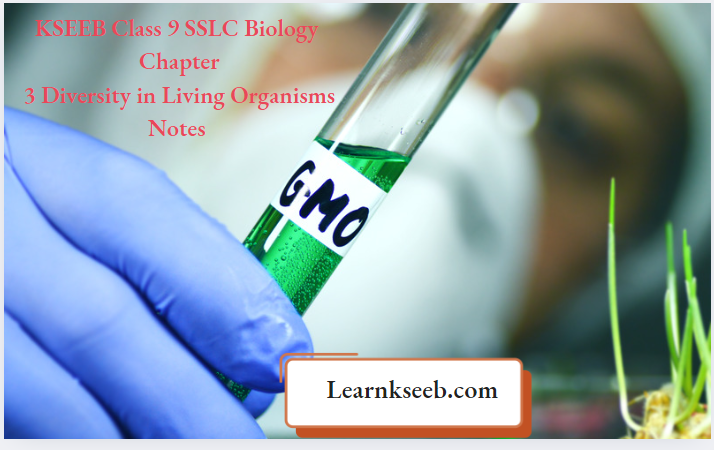
Does biodiversity remain unchanged over a period of time?
- Since in any given area many different life forms live together and share tire environment and its resources, they arc affected by each other also. During this process of co-existence, a stable community of different species is formed.
- In recent times, the balance of community with environment has also largely changed due to human involvement The diversity in such communities is affected by characteristics of land, water, climate, etc. Changes in the genetic make-up also bring about morphological changes leading to biodiversity.
What are the regions of rich biodiversity?
- The tropical regions ranging between the Tropic of Cancer and the Tropic of Capricorn are rich in diversity of microorganisms, plant and animal life.
- This is because of the warm and humid climate in the tropical region. This region is also called the region of mega diversity. Only a few countries contain more than half the biodiversity available on earth.
- These are Brazil, Colombia, Peru, Ecuador, Mexico, Zaire, Madagascar, Australia, China, India, Indonesia and Malaysia.
What is Classification
- Classification means identifying similarities and differences between different kinds of organisms and then placing these groups in an order of close relationship.
- In other words, biological classification attempts to group living organisms according to how closely related these organisms are. This is called phylogenetic system of classification.In the eighteenth century Carolus Linnaeus considered as ‘Father of Taxonomy’ developed a way of naming and classifying organisms.
- The study of the kinds and diversity of organisms and the evolutionary relationships among them is known as systematic.? (Gfc. systema – system, ikos – body of facts) or taxonomy (Gfc. taxis – arrangement, L. nominalis – belonging to a genome). These studies result in the description of new species and the organization of animals into groups based on evolutionary relationships.
- To understand classification in a simple way, let us take one example. Suppose you are given a basket full of different kinds of fruits, and you are asked to separate them on the basis of their similarity and morphological appearance. Then you will place oranges with oranges, grapes with grapes, apples with apples and so on.

What is the Basis of Classification?
- Since time immemorial, attempts have been made to classify living things into groups. Aristotle classified animals according to very simple way by just looking at life as to whether they lived on land, in water or in air. However, this categorization did not provide an exact basis of classification as there were differences among animals living in water, on land or in air. For example, in water you find many lands of fish, corals, octopus, etc. All of them live in water, yet they are very different from each other.
- Thus, it is necessary to first identify characteristics on the basis of which the broadest division can be made. Then, this is followed by the next set of characteristics for making sub-groups within these broader divisions. In this way, each time a new characteristic can be taken to further classify each group.
What do we mean by characteristic?
- A characteristic Is a particular form or function exhibited by organisms. For example, five fingers in each hand in humans is a characteristic. Plants do not contain fingers and thus are different from humans.
- There are some characteristics which are broader and widely found. On the other hand, there are some characteristics that arc at microscopic level. The broader characteristic is followed by limiting characteristics or small characteristics.
- The characteristic at the next level would be dependent on the previous characteristic and would decide the variety in the next level.
- This way a hierarchy of mutually related characteristics, to be used for classification, is built.
Some examples of characteristics used for a hierarchical classification are
- Presence or absence of membrane-bound organelles: All eukaryotic cells have membrane- bound organelles such as nucleus and mitochondria. The membrane bound organelles allow cellular processes to be carried out efficiently in isolation from each other. In organisms that do not have dearly demarcated nucleus and other organelles, biochemical pathways take place in a very different way. This would have an effect on ever)’ aspect of cell structure. Thus, presence or absence of membrane- bound organelles will act as a basic characteristic in classification of different organisms.
- Occurrence of cells singly or in groups: This is another characteristic that is taken into consideration while classifying living beings. Do cells live singly (unicellular) or in groups (multicellular) and does each group live as an individual group? Some cells such as Amoeba live singly, while some cells group together to form an individual. Cells that group together to form a single organism use the principle of division of labour.
- In such cases, all the cells forming an individual would not be similar. Instead, group of cells would cany out specialized functions. This would result in a very basic distinction in the body design of organisms. As a result, you find many differences in the body structure of single-celled organisms such as Amoeba and multicellular organisms such as worms and humans.
- Mode of food procurement: What is the mode of procurement of food? Whether organisms produce their own food through photosynthesis (autotrophs) or depend on food manufactured by others (heterotrophs)?
- What is the level of organization in the photosynthetic organisms (plants)?
- In animals, how does an individual’s body develop and organize its various parts. What is the specialization in organs to perform different functions?
- In all of the above questions, a hierarchy is developing. Tims, the characteristics of body structure used for classifying plants will be different from those used for classifying animals as the basic structures of plants and animals arc different These structural features are then further used to make sub-groups, rather than making broad groups.
KSEEB Biology Chapter 3 Diversity In Living Organisms solved Questions
Diversity in Living Organisms Importance of classification
- A wide variety of organisms on the earth can be easily studied by classification.
- Classification gives a summary of all life forms at a glance.
- It helps us understand the relationship between different groups of organisms and helps in understanding their evolutionary history.
- It serves as a base for the development of other biological sciences such as ecology and behavioural sciences, biogeography and evolution.
- It helps in understanding the characteristics of whole group of organisms by studying only a few representatives from that group.
- It helps us in the identification and classification of different organisms such as agricultural pests, pathogens and components of an ecosystem on which various fields of applied sciences such as agriculture, public health and environmental biology depend.
Diversity in Living Organisms Classification And Evolution
- In the previous section, you have studied that all living things are identified and categorized on the basis of some characteristics such as their body structure in form and function, mode of nutrition etc.
- Out of many characteristics, some characteristics are dominant and are likely to produce wide-ranging changes in body structure than others. Time also plays an important role in this. Some characteristics appear earlier in the body structure while other characteristics appear late. Thus, those characteristics which came into existence earlier arc likely to be more basic and fundamental than characteristics that came into existence later. So, we can say that once a certain body structure has come into existence, it will be the basis for other changes in the body structure that happen subsequently. Thus, the classification of life forms will be closely related to their evolution.
- However, one question arises here as to what is evolution?
- Evolution is the process of gradual change or development in different kinds of living organism. Most life forms that exist today have arisen by an accumulation of changes in body structure over a period of time. This has allowed an organism to possess them for his/her better survival. It was Charles Darwin who for the first time described this idea of evolution in 1859 in his book, The Origin of Species.
- This idea of evolution can be linked to classification. According to Darwin, there are some organisms with primitive body structure that have not changed much over a period of time. These are called older or primitive or lower organisms, which arc simple. On the other hand, there are other groups of organisms that have acquired their peculiar body structure quite recently. They have a complex body structure. They may be considered as the younger or advanced or higher organisms. Since the complexity in body structure is likely to increase over a period of time, we may say that older organisms are simpler, while younger organisms arc more complex and have evolved from the simpler organisms.
KSEEB SSLC Chapter 3 Diversity In Living Organisms Key Points For Class 9
The Hierarchy In Classification Of Groups
Each, organism is classified on the basis of its evolutionary relationship with other groups of organisms. Biologists such as Ernst Haeckel (1894), Robert Whittaker (1959), and Carl Woese (1977) tried to classify all living organisms into broad categories. These broad categories are called kingdoms.
Kingdoms – Two Or five ?
- The largest group of organisms recognized by biologists is the kingdom. But how many kingdoms should be there? Earlier, there were only two kingdoms of classification, namely plants and animals. This, however, caused problems in classifying fungi, bacteria and single-celled organisms, which do not fit into either kingdom – plant or animal.
- R H Whittaker in 1969, suggested the five kingdom classification on the basis of cell structure i.e. presence or absence of a nucleus, body organisation (unicellular or multicellular) and mode of nutrition. The five kingdoms that are recognized by Whittaker are -Monera, Proto ctista (Protista), Fungi, Plantae and Animalia. Later another Biologist, Woese, introduced modification by dividing Monera into Archacbactcria (or Archaea) and Enbacteria (or bacteria).
- further classification is done by naming sub-groups at various levels in the following scheme

- By grouping organisms on the basis of hierarchy of characteristics into smaller groups, one can arrive at the basic unit of classificatiou which is species.
Species
- The lowermost category is the species. Each organism is classified into a particular species. It is the basic unit of classification.
- Members of a species interbreed to produce fertile offsprings, which can perpetuate.
- Apart from small variations, members of a species arc almost identical in their anatomy, physiology and behaviour.
- Members of a species often resemble each other very closely in appearance (but are not exactly similar). For example, tigers belong to species tigris, humans belong to species sapiens. Thus, the scientific name for tigers is Panthera tigris and for humans is Homo sapiens.
Genus
- Closely-related species are grouped into a genus (plural genera). Thus, genus is a group of species which have common external resemblance. For example, lion (Panthera leo), leopard (Panthera pardus) and tiger (Panthera tigris) are three different species but belong to one genus Panthera.
Family
- Groups of similar genera are grouped together into a family. For example, cat (Felis domestica) and tiger (Panthera tigris) belong to the same family, Felidae.
Order
- Similar families are grouped together into orders. For example, humans and apes arc grouped together into the same order, Primates. Git (Felidae) and dog (Canidae) are grouped together into the same order, Carnivora.
Class
- Similar orders arc grouped into classes. For example, we belong to the class Mammalia along with other orders like Carnivora that includes tiger, dog and cat.
Phylum
- Closely-related classes arc grouped into phylum. For example, classes like mammals, fish, amphibians, reptiles and birds all belong to the phylum Chordata.
Kingdom
- Similar phyla constitute a kingdom. For example, all animals belong to kingdom Animalia and all plants belong to kingdom Plantae.
KSEEB Class 9 Biology Chapter 3 Diversity In Living Organisms Explained
Nomenclature-Scientific Naming of Organisms Activity 1
- To study the common names of some animals and plants in different languages
- Look for the names of some common animals and plants. Find out the common names of these in different languages.
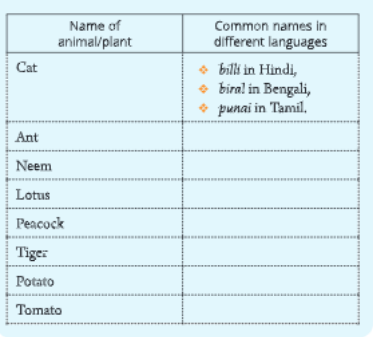
- From the above activity, we can conclude diat different animals and plants have different names. A cat is called billi in Hindi, biral in Bengali and punai in Tamil. There are different names of a cat in Arabic, Russian and French.
- Thus, a need was felt to assign a particular organism with an internationally acceptable name in the same manner as the chemical symbols and formulae of various substances are used throughout the world. Thus, a simplified system of naming organisms called Binomial nomenclature was proposed by Carl Linnaeus (1707 1778).
- Binomial nomenclature means a two-name system of naming organisms. The scientific name of an organism is thus unique and can be used to identify it anywhere in the world.
- Under Binomial system of nomenclature, each organism lias a scientific name consisting of two parts. The first part is genus and the second part is the species. For example, the scientific name of mango is Mcmgifera indica, scientific name of house fty is Musca domestica and scientific name of the common Indian frog is Rana tigrina
Mainly, the following rules arc applied to scientific names:
The name of the genus comes first and its first letter is always capitalized. The name of the species comes second and starts with a small letter. For example, the binomial name for humans is Homo sapiens. In this, Homo is the genus, starting with a capital letter while sapiens is the species starting with a small letter
- The scientific name is printed in italics or underlined (separately for genus and species name) if handwritten. For example, Homo sapiens or
- Scientific names are mostly in Latin and are accepted all over the world.
Nomenclature-Scientific Naming of Organisms Activity 2
- To study the scientific names of some common plants and animals
- Given below is a table giving common names of some plants and animals. Find out the scientific names of these and write them down

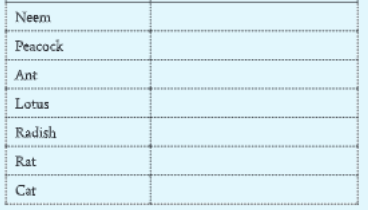
Five Kingdoms
Kingdom Monera
(Gk. monos: single)
- The organisms belonging to kingdom Monera are the oldest, simplest and prokaryotic microorganisms. They have following characteristics:
- These are prokaryotes. They do not have a defined nucleus or organelles.

- They are unicellular, but may be present in the form of colonies or filaments of independent cells.
- Some of them have cell walls while others do not have (for example Mycoplasma).
- Their mode of nutrition is mainly autotropluc (i.e. synthesizing their own food, for example some bacteria and blue-green algae) or sometimes heterotrophic (i.e. getting it from the environment by absorption, for example Mycoplasma).
- They are usually non-motile, but some may have flagella and gliding movements. Cilia arc absent.
- – Their reproduction is primarily asexual (by fission).
- Examples: Bacteria (E. coliVibrio cholerat etc.), blue-green algae or cyanobacteria (Anabama, Nostoc etc.) and Mycoplasma.
Kingdom Protista
(Gk. Protista: first)
The organisms belonging to kingdom Protista include unicellular eukaryotic organisms. Primarily, they are aquatic and occur in oceans, lakes, ponds and damp soils.

They have the following characteristics:
- They are first eukaryotes, having a well-defined nucleus and complex membranous organelles. They are unicellular or colonial forms without distinct division of labour.
- Some have cellulose wall and chloroplast and their mode of nutrition is autotrophic (algae). Some do not have cell wall and chloroplast and are heterotrophic (Protozoans),
- They have hair-like cilia (Paramecium) or whip- likc flagella (Euglena) or pscudopodia (Amoeba) for moving around.
- Examples: Unicellular algae, diatoms, protozoans (Paramecium, Amoeba, Euglena), etc.
Class 9 SSLC Biology Chapter 3 Notes With Diagrams
Kingdom Fungi
- The organisms belonging to kingdom Fungi include heterotrophic (without chlorophyll) eukaryotic organisms living as parasites or saprophytes.
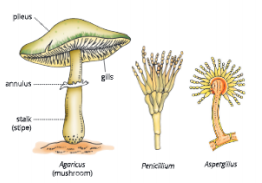
- They have a definite cell wall made up of tough complex sugar called chitin.
- They grow in dark and moist habitat and use dead organic matter as food. Hence, they are called saprophytes.
- Many of them have the capacity to become multicellular organisms at certain stages in their lives except yeast which is a unicellular fungus.

- They arc usually non-motilc.
- They reproduce mostly by spore formation. However, sexual reproduction may also take place. Examples: yeast, mushrooms, etc.
- Some fungi live in mutual relationship with algae or blue- green algae (cyanobacteria). Such a relationship is called symbiotic relationship. These symbiotic forms are called lichens that are usually found growing on the bark of trees.
Kingdom Plantae
- Kingdom Plantae includes all organisms that arc truly multicellular eukaryotes with cell walls. All plants are included in this kingdom. Die plantae are distinguished by the following characteristics:
- They are multicellular eukaryotic organisms adapted to carry out photosynthesis. Hence, they are autotrophic.
- They perform photosynthesis with the help of chlorophyll present in cliloroplasts.
- They have a cell wall made up of true cellulose, enclosing cytoplasm with large vacuole.
- They are non-motile, without definite shape or size.
- We will stud)r about kingdom Plantae in later sections of this chapter.
Kingdom Animalia
- Kingdom Animalia includes all those organisms which are multicellular eukaryotes without cell walls. They are heterotrophs as they caimot synthesize their own food. We will study about kingdom Animalia in later sections of this chapter.
Kingdom Plantae (Plant Kingdom)
- All plants arc multicellular, photosynthetic and contain chloroplast in their cells. Most of the plants are adapted for living on land.
- Plants can be classified at three levels.
- Level one: Whether plant body is well- differentiated and has distinct components.
- Level two: Whether the differentiated plant body has special tissues for the transport of wrater and other substances within it Level three: Whether plants are able to bear seeds and whether the seeds are enclosed within the fruits.
- The plant kingdom includes algae, mosses, liverworts, ferns, conifers and flowering plants.
Sub-KingdomCryptogamae
(Gk. crypto: hidden, gamous: marriage)
- The plants belonging to sub-kingdom Cryptogamae are also known as lowrer group of plants, flow’erless or seedless plants. ’Ihesc plants do not bear external flowers or seeds and hence are considered to have hidden reproductive organs. The sub-kingdom cryptogamae is further divided into three divisions, namely, Thallophyta, Bryophyta and Pteridophyta.
Division Thallophyta
(Gk. Txatlus: undifferentiated, phyton: plant)
Characteristics of division Thallophyta
- The plant body is not differentiated into roots, stems and leaves. It is in the form of an undivided mass of cells called thallus.

- Vascular system is absent, o These plants are predominantly aquatic.
- The thallophytcs mainly include algae.
- Examples: Spirogyra, Chora, Cladophora, Ulothrix, Ulva, etc.
Division Bryophyta
(Gk. Bryotu moss, phyton: plant)
The bryophytes are amphibians of the plant kingdom. The bryophytes include mosses and liverworts. They usually range from 2 cm to 15 cm in length. They are unable to grow tall because they do not have xylem to support them, nor do they have a vascular system for transport of materials. They do not have true roots.
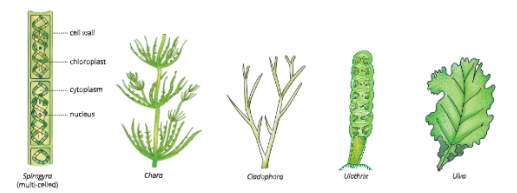
Characteristic features of division Bryophyta
- These are simplest land plants with no true roots. The body of the plants is simple, flat and usually differentiated into stems and leaf-like structures.
- They do not have specialized tissues for conduction of water and other substances horn one part of the plant to another. This means that bryophytes do not have conducting or vascular tissues,xylem and phloem. Thus, they are called noil-vascular cryptogamic plants.
- The plants develop a number of hair-like structures at their lower ends. These are known as rhizoids. Rhizoids help in fixing the plant to the soil and absorbing nutrients.
- Tire)’ haw chlorophyll and thus can manufacture their own food tlirough photosynthesis.
- ‘ Bryophytes show alternation of generations, i.e. they possess two types of generations – gametophyte and sporophyte.
- These plants mainly live in damp, shady places.
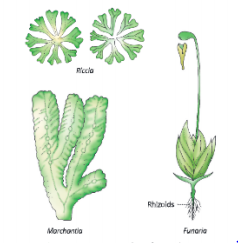
- Examples: Ricciti, Mafchantia (liverwort), Funaria (moss), etc.
Division Pteridophyta
(Gk. Pteroti: feather, phyton: plant)
- The term ‘pteridophyta is derived from the Greek word pteron meaning feather. This is because pteridophytes have fcathcr-likc or pinnate fronds. Pteridophytes are seedless vascular plants that have sporophytic plant body. They are also called vascular cryptogams as they possess well-developed conducting system, i.e. vascular elements such as xylem and phloem. They grow well in shady areas like forests, mountain slopes and hills, especially in the tropical rain forests.
Class 9 SSLC Biology Chapter 3 Notes With Diagrams
Characteristic features of division Pteridophyta
- The body of pteridophytes is differentiated into true stem, leaves and roots like higher plants.
- They possess well-developed vascular tissues – xylem and phloem – for conduction of water and other substances from one part of plant body to another.
- Tire most conspicuous of pteridophytes are the ferns. They arc seedless vascular plants of humid tropical and temperate areas.
- Examples: Ferns (Nephrolepis), horse-tails (Equisetum), club mosses (Selaginella) and Marsilea. The major differences between Bryophyta and Pteridophyta.
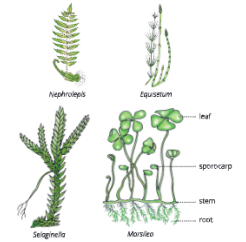

Sub-Kingdom Phanerogamae
(Gk. Phaneros: visible, gamos: marriage)
- The plants belonging to sub-kingdom Phanerogamae arc 9ccd bearing plants. The body of these plants i3
- differentiated into true roots, stem and leaves. ‘Ihe vascular system composed of xylem and phloem is well- developed. The reproductive organs are multicellular seeds and an embryo develops from a fertilized egg. The major differences between Cryptogamae and Phanerogamae are given.
- Sub-kingdom Phanerogamae is further sub-divided on the basis of presence or absence of fruits (Le. whether the seeds are naked or enclosed in fruits) into two sub-divisions – Gyranospenoae and Angiospcrmae.
Sub-division Gymnospermae
- The term gymnosperm is derived from two Greek words – gyntno meaning naked and sperma meaning seed. Thus, gymnosperms are plants with naked seeds. They are found mostly in cold areas where snowfall occurs too often. All gymnosperms are perennial woody plants. Some of these live for thousands of years.
Characteristics of Gymnospermae
- The plants are differentiated into roots, stem and leaves.
- The stem is erect. It may be branched a.3 in Pinus or unbranched as in Cycas.
- Gymnosperms are a small group of seed plants. Seeds do not occur inside a fruit. They are naked or lie exposed on the surface of megasporophylls. o The seed contains a food-laden tissue called endosperm for the future growth of embryo.
- Examples: Cycas, Pinus, Ginkgo, Araucaria, Gnetum etc.
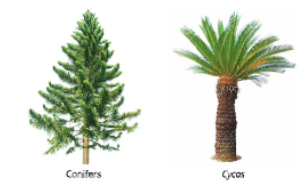

Sub-division Angiospermae
- The term angiosperm is derived from two Greek words – angio meaning covered and spertna meaning seed. Thus, angiosperms are plants with seeds covered by tire fruit ‘Die major differences between Gymnospermae and Angiospermae are given
- On die basis of number of corylcdons, angiosperms are divided into two groups – monocotyledonous or monocots (seeds with a single cotyledon) and dicotyledonous or dicots (seeds with two cotyledons). The major differences between monocots and dicots are given .
Free Notes For KSEEB Class 9 Chapter 3 Diversity In Living Organisms
Characteristics of Angiospermae
- These are flowering plants the seeds of which are enclosed in a fruit.
- The seeds contain cotyledons called seed leaves as in many cases they emerge and become green when the seed germinates. Thus, cotyledons represent pre-designed plant in the seed.
- After fertilization, ovary develops into a fruit.
- Xylem contains vessels and phloem contains companion cells.
- Examples; Pea, gram, maize, oats, rice, Hibiscus, Paphiopedilum, Ipomoen, mango, etc.
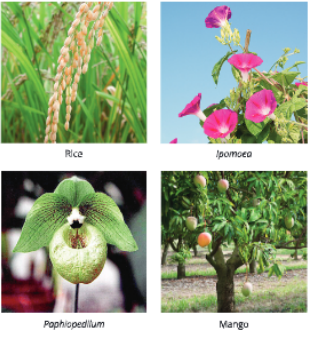

Activity-3
To study dicot and monocot seeds and plants Yon will need Seeds and plants of green gram, wheat, maize, peas, tamarind and water
Procedure
Take some seeds of green gram, wheat, peas, maize and tamarind. Soak them in water for one day till they become tender.
Try to split each seed into two halves. Do all of them split into nearly two halves?
Observation 1
- ‘The seeds that split into rwo halves are dicot seeds and die seeds that do not split are monocor seeds.
- Now take the plants of these and observe their roots, leaves and flowers.
- What is the root system – tap roots or fibrous roots?
- What is the type of venation – parallel or rericulate?
- How many petals are there in the flowers of these plants?
Carefully observe the above-mentioned characteristics and note them down in a table in your workbook.
Observation 2
You will observe that the wheat and oiaize plants (monocot) have fibrous root system, parallel venation and three or multiple of three petals.
On the other hand, dicot plants like green gram, peas and tamarind have tap root system, reticulate venation and five or multiple of five petals.

Kingdom Animalia
Let us discuss the various characteristic features of
kingdom Animalia before classifying them.
Characteristic features of kingdom Animalia
- These are multicellular organisms.
- These arc eukaryotic organisms, that is, the cells do not contain cell wall, but contain only cell membrane and membrane-bound organelles (like nucleus).
- They are heterotrophs.
- They are mostly mobile.
- They show increased sensitivity through the nervous system.
Let us now study about the phyla included in kingdom animals
Major Phyla Of Kingdom Animalia
Based on die extent and type of body structure differentiation, the kingdom Animalia is divided into two groups, namely, Invertebrate (non-chordata) and Chordata. A broad division of kingdom Animalia is given in
Phylum Porifera – organisms with pores
‘Ihe word porifera means organisms with pores or holes all over their body. Phylum Porifera includes sponges. Porifera are multicellular organisms with cellular level of body organisation.
KSEEB Class 9 Diversity In Living Organisms Chapter 3 Notes With Examples
Characteristics of Phylum Porifera
- These are non-motile organisms fixed to the solid surface. They are commonly called sponges and found in marine habitats, i.c. oceans.
- The body has many pores (ostia) or holes. These pores form canal system. Water flows through canals and brings food and oxygen with it. It is then passed outside through osculum, a large aperture present at the upper end of the body.
- Body encloses a large cavity called spougococl.
- Body is covered with a hard outer skeleton.
- The body of sponges has minimal cellular differentiation and almost no tissue organization. That means that though sponges arc multicellular organisms, their cells are not organized to form tissues.
- They are mostly sessile. No organs, movable parts or appendages are present.
- The sponges reproduce asexually by budding and gcnunulc formation and sexually tlirough fertilization. They have great regenerating capacity. Examples: Sycott, Euplectella, Easpongia, Spongilla, Leucosolaua, etc.
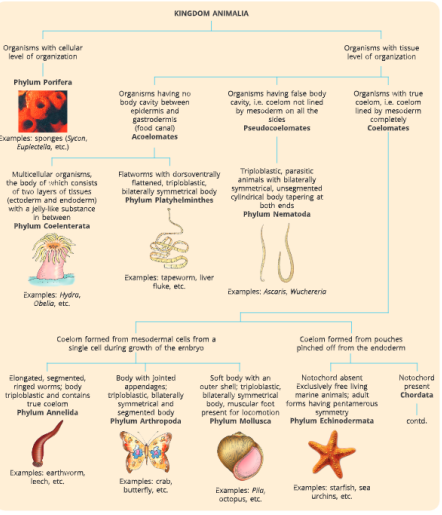
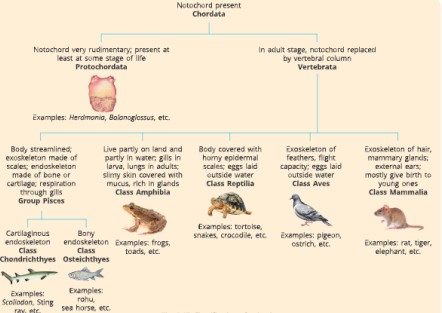
Phylum Coelenterata (Cnidaria)
- The phylum Coelenterata includes Hydra, jelly fish, sea anemones and corals. Coelenterates are multicellular organisms which have tissue level ot organization. Their body consists of two layers of tissues (ectoderm and endoderm) with a jelly-like substance in between.
- The coelenterates mostly live in fresh water, in solitary or colonial forms. Some like Hydra may be seen with naked eyes and can be found attached to stones or aquatic plants.
Characteristics of Phylum Coelenterata
- The body has no head and no segmentation. The body shows tissue level of organization.
- These animals have two germ layers, namely, ectoderm and endoderm; one layer makes up the cells on the outer side of the body (epidermis)

- and other layer makes the inner lining of the body (gastrodermis). There is a jelly-like substance in between.
- The mouth is surrounded by a ring of tentacles. Tentacles contain nematocysts (stinging cells) called cnidoblasts.
- The body has a gut cavity (called coelenteron) with a single opening for food and waste material.
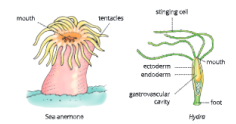
- Some of the species of coclcntcrates live in colonics (such as corals), while some live a solitary life (such as Hydra).
- Reproduction may be asexual!)’ or sexually.
- Examples: Hydra, Obelia, sea anemone (Metridiutu), Aurelia (Jelly fish), etc.
- The major differences between Porifera and Coelenterata (Cnidaria) are given in Table 3.5.
- Hydra. a coelenterate, has great regenerating power. If it is cut into several fragments, each fragment will grow into a new Hydra.
Phylum Platyhelminthes – the flatworms
(Gk. Platy: flat; helminth: worm)
- The Platyhelminthes are flatworms. Flatworms live in moist places. The body of platyhelminthes has complex body organization in comparison to poriferans and coclcntcrates.
- They range from a few millimetres to a few centimetres in size.
Characteristics of Phylum Platyhelminthes
- Their bodies are dorsoventraUy flattened. That is why, they are called flatworms.
- The body is bilaterally symmetrical with the left and right sides of the body having the same design.
- They are triploblastic animals (body made of three germ layers – ectoderm, mesoderm and endoderm from which tissues can be formed). This allows formation of outer and inner bodylinings and some organs.
- They possess a mouth but no anus.
- There is some degree of tissue f ormation. However, there is no true coelom or internal body cavity, in which well-developed organs can be accommodated (housed).


- They arc either free-living (such as planarians) living in water and soil or parasitic (such as liver flukes) living inside the body of other organisms. They have suckers or hooks or both for attachment to the body of the host.
- Reproduction takes place mostly sexually, but few reproduce asexually too. They are mostly hermaphrodite (both sex organs in the same body). Examples: Tapeworm, liver fluke (Fasciola hepatica), Planaria, etc.
Phylum Nematoda (or Nemathelminthes)- Parasitic worms or roundworms
(Gk. Nema: thread; helminth: worm)
- The organisms belonging to this phylum are also known as Aschelminthes. They are mostly parasites having slender, elongated bodies tapering at each end.
KSEEB SSLC Biology Chapter 3 revision Notes For Diversity In Living Organisms
Characteristics of Phylum Nematoda
- They are triploblastic animals (body wall having three germ layers).
- The body is bilaterally symmetrical and unsegmented, and is cylindrical (rather than flattened).
- The body has tissue level of organization. However, no real organs are present.
- The body cavity is a pseudocoelom, i.e. no true coelom is present
- The organisms are mostly parasites having slender, elongated bodies tapering at each end.
- They are parasitic worms that cause diseases such as elephantiasis (caused by filarial worms) and intestinal disorder (caused by roundworms or pinworms). Ascaris lumbricoides is a common roundworm living in the intestine of humans.
- They have a definite digestive system that runs along the length of their body. They have a mouth, pharynx, intestine and anus. Sexes are separate, males are smaller than females.
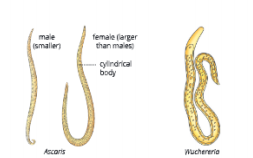
- Examples: Ascaris(roundworm),Enterobius (pinworm), Wuchereria (filarial worm)etc.
- The major differences between Platyhclminthes and Nemathelminthes are given.
Phylum Annelida – the ringed worms
(Gk. annulus: ring; idos: form)
- Organisms belonging to phylum Annelida arc worms with body appearing as if made up of a series of rings. It includes earthworms, ragworms (Nereis) and leeches. They arc first animals with true coelom.
Characteristics of Phylum Annelida
- The are elongated, segmented, worm-like animals.
- Body is triploblastic and contains true coelom. This allows true organs to be packaged in the body.
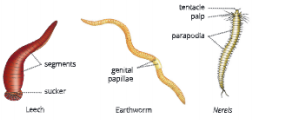

- The body is bilaterally symmetrical.
- The have organ level of organization, i.e. extensive organ differentiation.
- They have a well developed brain, ventral nerve cord, dorsal and ventral blood vessels.
- The body is provided with setae or parapodia for locomotion.
- Their body is mctamcrically segmented (made up of a series of similar segments). Each segment is lined up one after the other from head to tail, and possesses a similar pattern of organs, such as nerves, blood vessels and excretory organs.
- They are found in diverse habitats ranging from freshwater, marine water to land.
- Examples: Pheretima (earthworm), leech, Nereis (sandworm), Aphrodila (sea mouse), etc.
Phylum Arthropoda – organisms with jointed appendages
(Gk. Arthro: jointed; pod: legs)
- Organisms belonging to phylum Arthropoda have jointed appendages (legs and antennae).
- This is the largest invertebrate phylum. Insects, centipedes, millipedes and spiders arc the common organisms belonging to phylum Arthropoda.
Characteristic features of Phylum Arthropoda
- The body is bilaterally symmetrical and segmented.
- They are triploblastic animals.
- The body (coelomic) cavity is reduced and filled with blood, thus called haemocoel. There is an open blood circulatory system and the blood docs not flow in well-defined blood vessels.
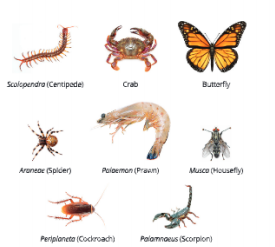
- The body is segmented into two regions – cephalothorax (head and thorax together) and abdomen, or three regions – head, thorax and abdomen.
- They have jointed appendages (legs).
- They possess a hard exoskeleton made of chitin.
- Examples: Crab, butterfly, dragonfly, housefly, prawn, scorpion, spider, etc.
The major differences between Annelida and Arthropoda are given
Phylum Mollusca
- The organisms belonging to phylum Mollusca have an outer shell and soft body. The fold of skin around the body is called mantle which secretes the outer shell. They have muscular foot which is used for movement.
- Phylum Mollusca includes slugs, snails and octopus.
Characteristics of Phylum Mollusca
- These are triploblastic animals with a coelom- The coelomic cavity is reduced.
- The body is bilaterally symmetrical.
- They live in terrestrial or aquatic habitat
- The body is unsegmented or with little segmentation.
- The body is soft, often protected by a hard calcareous shell.
- They have a muscular foot on their ventral surface for moving around.
- They have an open circulatory system.
- They have kidney-like organs for excretion. Examples: Snail, Chiton, Pila, Utiio, octopus, etc
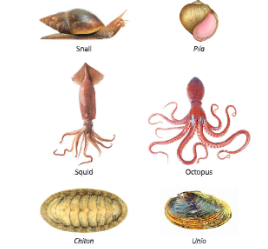
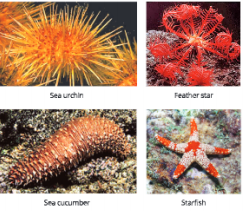
Phylum Echinodermata – organisms with spiny skin
- The word Echinodermata has come from Greek words echinos meaning spiny and derma meaning skin. Thus, they are organisms with spiny skin.
- Characteristics of Phylum Echinodermata
- They are triploblastic coelomate animals.
- They are exclusively free-living marine animals living in sand at the bottom of the sea.
- Their body is unsegmented. There is no head and body surface lias five radial anns (pentamerous symmetry).
- They move by tube feet The body cavity has water-vascular system.
- They possess calcareous exoskeleton made up of calcium carbonate with spiny skin all over the body.
- They have a water driven tube system that they use for locomotion.
- Examples: Asterias (starfish), Echinus (sea urchin), Holothuria (sea cucumber), Antedon (feather star), etc
Class 9 KSEEB Biology Chapter 3 Taxonomy And Classification Notes
Sub-Phylum Protochordata
The word Protochordates means primitive chordates. They possess notochord at some stage of their life. Notochord (chord means string) is a stiff rod-like structure that runs along the back of the animal and separates nervous tissue from the gut It also provides a place for muscle attachment for easy movement.
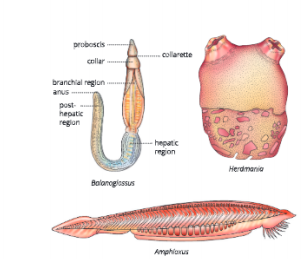
Characteristics of Sub-Phylum Protochordata
- They are triploblastic animals with a coelom.
- The notochord may not be present in all stages in their lives. It does not run along the entire length of die animal body.
- They are marine animals.
- Examples: Batanogfossus, Herdmania, Amphioxus.
Phylum Chordata
(Sub-Phylum Vertebrata)
The vertebrates are triploblastic, coelomate animals with bilaterally symmetrical body. They include the fish, amphibians, reptiles, birds and mammals. Vertebrates have a true vertebral column and internal skeleton, which allows a different distribution of muscle attachment points for movement of the body parts. They have complex differentiation of body tissues and organs. The major differences between Nonchordata and Chordata are given in Table 3.8.
Characteristics of chordates
- Presence of notochord: In some stages of their life, all chordates possess a stiff rod-like structure (called notochord) running along the body, close to die dorsal surface.
- Dorsal tubular nerve cord: They have a dorsal, hollow, tubular nerve cord close to the notochord.
- They are triploblastic animals with diree germ Layers.
- They have paired gill pouches in some stages of their life.
- They are true coelomate animals.
- Vertebrates are fiirther grouped into five classes.
Group Pisces (fish)
The group called Pisces contains many classes. They are all exclusively water living (aquatic) animals. Some well-known examples are cartilaginous fish (entirely cartilaginous endoskeleton), such as sharks and bony fish (bony and cartilaginous endoskeleton) such as tuna or rohu. The cartilaginous fish belong to Class Chondrichthycs, and the bony Osh belong to Class Osteichthyes. These are the two classes under the Pisces group.
Characteristics of Group Pisces
- They have a cartilaginous skeleton or bony skeleton.
- They live exclusively in water. The body is streamlined, which allows easy movement in water. They possess fins and muscular tail for locomotion.
- They possess gill slits for water to move inside die body for respiration. Pour to seven pairs of gills are present. They obtain oxygen dissolved in water with die help of gills.
- Eyes are without eyelids. They possess nostrils that help in olfaction.

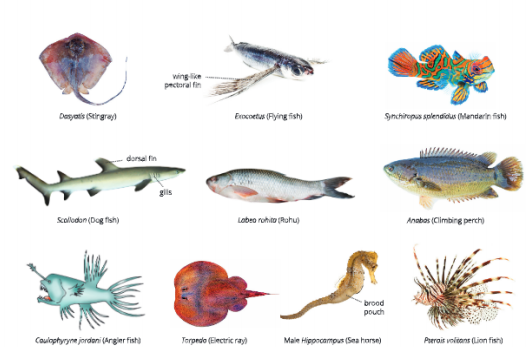
- The body is covered with overlapping dermal scales. The)1 are cold-blooded animals (i.e. their body temperature changes with the change in the outside temperature).
- The heart is two-chambered, unlike four-chambered heart in mammals.
- They lay eggs.
- Examples: Mandarin fish, angler fish, lion fish, rohu, sea horse, climbing perch, liilsa, mullet, electric ray, stingray, dog fish, etc.
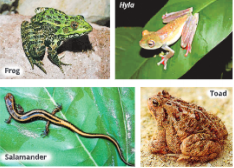
Class Amphibia
(Gk.Ainphi: double or both; bios: life)
The amphibians have evolved from fish. Thus, they are adapted to partly live on land, and partly in water. They differ from fish as they do not possess scales. They have three-chambered heart and mucous glands in die skin.
Characteristic features of Class Amphibia
They live partly in water and partly on land. Larval stage has a tail and live in water Adults may live in water as well as on land.
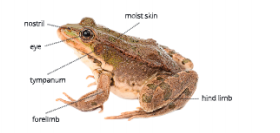

- They have smooth skin. It is covered by mucus, which keeps the skin moist and slippery.
- They have two pairs of limbs. Digits do not have claws.
- Respiration takes place either duough gills or lungs. Heart is thrce-chambercd.
- Most amphibians lay their eggs in water, where they develop into tadpoles. The tadpoles after metamorphosis become adults and can live in water as well as on land.
- Examples: Toad, frog, salamander, tree frog, etc
Class Reptilia (Gk. Repere: to crawl)
They are the cold-blooded animals with their body covered with horny epidermal scales. The animals belonging to Class Reptilia can live solely on land and are very less dependent on water. They lay eggs covered with waterproof shells, so they need not lay eggs in water, like amphibians. Their skin is waterproof and covered with protective homy scales.
Characteristics of Class Reptilia
- They are cold-blooded animals.
- Their body has a head, neck, trunk and a tail.
- Their body is dry and covered with homy, scaly epidermal skin.
- The)- have two pairs of limbs on their trunk.
- They have lungs tor breathing and respiration.
- Most of them have three-chambered heart (four-chambered in crocodiles).
- They lay eggs covered with waterproof shells, so they need not lay eggs in water like amphibians. Examples: Wall lizards, snakes, turtle, flying lizard,chameleon, crocodiles, etc.
Summary Of KSEEB Biology Chapter 3 Diversity In Living Organisms For Class 9
Class Aves (Gk. Avis: bird)
Birds evolved from reptiles and have many similarities with them. Birds are easily distinguished because their bodies are covered with feathers. All birds are warm¬blooded and have four-chambered heart.
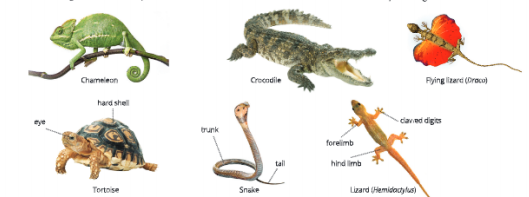
Characteristics of Class Aves
- They have feathers and scales covering their bodies.
- They are warm-blooded animals (Le. their body temperature does not change with outside temperature).
- o The body is divisible into three parts – head, neck and trunk.
- Their forelirabs are modified to form wings tor flight.
- Heart is four-chambered.
- Their jaw has a homy beak- Teeth are absent.
- They have lungs for respiration.
- They lay eggs.
- Examples; Pigeon (Columba livia), house sparrow, crow, white stork, penguin, male tufted duck, etc.
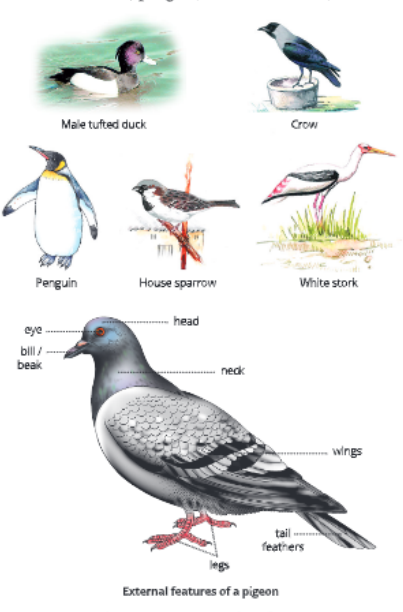
Class Mammalia
(Gk. Mamma: breast)
- All mammals possess mammary glands that are more developed in females than in males to suckle their young ones. Like birds, mammals are also warm¬blooded animals. Mammals have body covered with hair.
- All female mammals secrete milk on which their young ones feed.
Characteristics of Class Mammalia
- They possess mammary (milk) glands. They secrete milk to feed their young ones.
- Their body is covered with hair. Sweat and oil glands arc also present in the skin.
- The body is divided into head, neck, trunk and tail. Tail is absent in some mammals. They have four limbs.
- Except two mammals,the platypus and the echidna(spiny ant-eater) which lay eggs,all other mammals give birth to young ones.Kangaroos give birth to very poorly developed young ones.
- Sexes arc separate – male and female.Their young ones usually develop inside the uterus of die mother.
- Heart is four-chambered.
- They are warm-blooded animals.
- Examples: Rat (Rattus rattus), human, tiger, elephant, cat, whale, bat, etc.
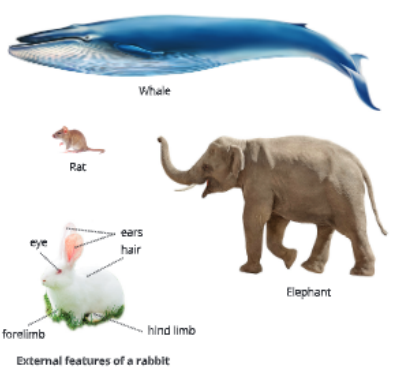
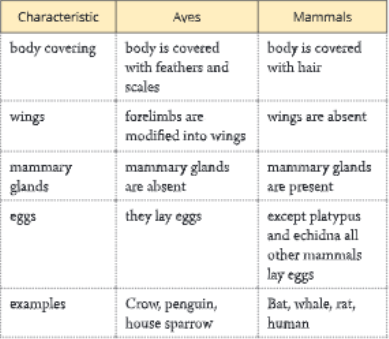
Summary
- Classification means grouping organisms on the basis of their similarities and dissimilarities.
- The scientific naming of organisms is according to the Linnaeus system of Binomial Nomenclature.
- As per modern Whittaker system of classification, there are five kingdoms of living organisms namely, Monera,Protista, Fungi, Plantae and Animalia.
- Monerans do not have a defined nucleus or cell organelles, nor do they show multicellular body structure.
- Protists include unicellular eukaryotic organisms such as algae, diatoms and protozoans.
- Organisms belonging to kingdom fungi are heterotrophic eukaryotic organisms which use decaying organic matter as food material.
- Yeast and mushrooms are Included in kingdom fungi.
- All multicellular eukaryotes, which are photosynthetic autotrophs, are grouped under kingdom Plantae.
- Kingdom Plantae is classified into two sub-kingdoms – Cryptogamae and Phanerogamae.
- Thallophyta are plants that have undifferentiated body.
- Bryophyta are amphibians of plant kingdom.
- Pteridophyte are vascular plants that do not produce seeds.
- Gymnosperms are plants that bear naked seeds.
- Angiosperms are plants that bear seeds enclosed inside fruits.
- Angiosperms are divided into two classes depending upon the number of cotyledons in their seeds monocotyledons and dicotyledons.
Part A – Our PASTS – III (History)
- Chapter 1 How, When and Where
- Chapter 2 From Trade to Territory The Company Establishes Power
- Chapter 3 Ruling the Countryside
- Chapter 4 Tribals Dikus and the Vision of a Golden Age
- chapter 5 When People Rebel 1857 And After
- Chapter 6 Colonialism and the City: The Story of an Imperial Capital
- Chapter 7 Weavers, Iron Smelters and Factory Owners
- Chapter 8 Civilising the “Native” Educating the Nation
- Chapter 9 Women, Caste and Reform
- Chapter 10 The Changing World of Visual Arts
- Chapter 11 The Making of the National Movement 1870s -1947
- Chapter 12 India After Independence
Part B – Resources and Development (Geography)
- Chapter 1 Resources
- Chapter 2 Land,Soil, Water, Natural Vegetation and A wildlife Resources
- Chapter 3 Mineral and Power Resources
- Chapter 4 Agriculture
- Chapter 5 Industries
- Chapter 6 Human Resources
Part C: Social and Political Life -III (Civics)
- Chapter 1 The Indian Constitution
- Chapter 2 Understanding Secularism
- Chapter 3 Why Do We Need a Parliament ?
- Chapter 4 Understanding Laws
- Chapter 5 Judiciary
- Chapter 6 Understanding Our Criminal Justice System
- Chapter 7 Understanding Marignalisation
- Chapter 8 Confronting Marginalisation
- Chapter 9 Public Facilities
- Chapter 10 Law and Social Justice


